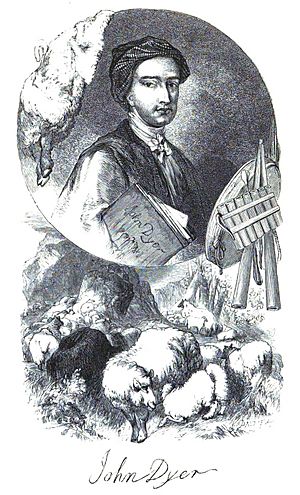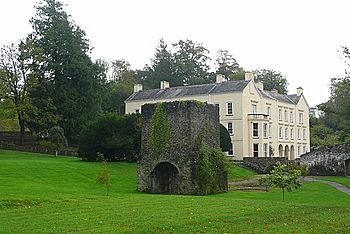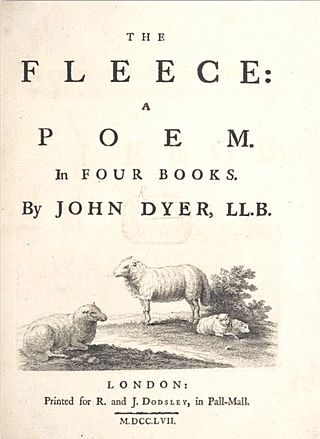John Dyer facts for kids
John Dyer (born 1699 – died 15 December 1757) was a Welsh painter and poet. He later became a priest in the Church of England. He is most famous for his poem Grongar Hill. This poem was one of six early works published in a collection in 1726. He also wrote longer poems like The Ruins of Rome (1740) and The Fleece (1757). Even though his poems were often included in collections rather than published alone, his talent was later recognized by famous poets like William Wordsworth.
Contents
John Dyer's Life and Work
Early Life and Education
John Dyer was born in Llanfynydd, Carmarthenshire, Wales. This was about five miles from Grongar Hill. He was the fourth of six children. We don't know his exact birth date, but he was baptized on 13 August 1699. His family moved to the large house of Aberglasney in 1710. This gave them more space.
Dyer first went to a country school. Later, he attended Westminster School in London. He didn't like Westminster School much. He even ran away for a few days once! He didn't learn much Latin there, which was a main subject.
After school, Dyer worked in his father's law office. He was good at law, but he really wanted to paint and write. His father wanted him to be a solicitor. This created a struggle for John between his artistic dreams and his family's plans. Growing up around the old stone buildings at Aberglasney made him interested in ancient things and nature. These interests later showed up in his poems.
John's father died on 8 July 1720. This ended John's law training. He was not named in his father's will, which freed him from handling the family's legal issues. So, in 1720 or 1721, John left Aberglasney and moved to London. He went there to follow his passion for painting and poetry.
Becoming a Painter and Poet
In London, John Dyer became a student of the artist Jonathan Richardson. Richardson believed that artists needed to learn many things. This included reading, observing nature, and studying works by great painters and writers. Dyer followed this idea, using his studies to create vivid word pictures in his poems. His first poem in a style similar to John Milton was for Richardson. It was called "An Epistle to a Famous Painter."
While studying with Richardson, Dyer met a group of friends at a coffee house. These friends included Thomas Edwards, Daniel Wray, George Knapton, and Arthur Pond.
In 1724, with Richardson's support, Dyer sailed to Italy. He went straight to Rome to continue his studies. He loved the ancient buildings there. The Pantheon was his favorite. He also admired the Colosseum and the Baths of Caracalla. He found inspiration for his poem The Ruins of Rome (written in 1740) from these places. However, he disliked what he saw as the religious practices of Catholicism.
While in Italy, Dyer became very ill with a fever. He started to think about his future. As he traveled north, he visited the ruins of Otricoli. This visit inspired a poem called "Written at Ocriculum in Italy, 1725." He then went to Florence. There, his interest shifted from classical art to Renaissance art. He even copied a famous painting by Antonio da Correggio, "Madonna Adoring the Christ Child." This is one of his few paintings that still exist.
After Dyer returned to England, six of his poems were published in Richard Savage's Miscellaneous Poems and Translations (1726). Dyer was part of a literary group where writers often wrote poems to each other. For example, Dyer wrote a poem to Savage, and Savage wrote one back to him.
Dyer also painted a portrait of a friend named Martha Fowke, who was known as Clio in their group. His poems "A Country Walk" and "The Inquiry" mention her. Another poem, "To Clio from Rome," also refers to his painting of her. Martha wrote back, praising both his poems and his paintings.
Later Life and Final Works
After returning to England and publishing his early poems in 1726, Dyer briefly went back to Aberglasney. He then spent several years between London and Herefordshire, or on painting trips. In 1734, he successfully managed a farm for his aunt. He spent more years as a farmer in other areas. During this time, Dyer started writing again. He wrote a poem called "My Ox Duke." He also began working on a longer poem about Wales, but it was never finished.
Eventually, he used his experiences from Italy to write The Ruins of Rome, published in 1740. Much later, in his poem The Fleece (1757), he used his knowledge of the wool industry gained from farming.
The Ruins of Rome was a descriptive poem. It was written in a style similar to John Milton's blank verse. It was published without his name in 1740. The poem shows Dyer's personal feelings about ancient ruins. This made it an early example of the "Age of Sensibility," which led towards Romanticism in poetry. This poem is known for helping to bring back a type of landscape poetry that focused on ancient ruins.
We don't know much about his paintings from this time, as most are lost. Some family portraits are thought to be his. He also painted two religious works: a "Last Supper" and a head of Christ. In 1741, Dyer traveled to Worcester to paint a portrait of Bishop John Hough. While there, he was convinced to become a priest in the Church of England. In September 1741, he became a deacon. By October, he was made a priest of Catthorpe in Leicestershire. He held this position for nine years.
Dyer married Sarah Ensor Hawkins, a 26-year-old widow. She was said to be a descendant of Shakespeare. They had several children. In 1751, he was given a better church position in Belchford, Lincolnshire. The next year, he also served in Coningsby. Later, he moved to Kirkby on Bain. In 1752, he earned a Bachelor of Laws degree from Cambridge. By this time, he had started writing The Fleece.
Living in the marshy areas of Lincolnshire was bad for Dyer's tuberculosis. He died in December 1757, a few months after his last poem was published. His main poems were published in 1761. Later, more collections of his work appeared. These included his earlier poems.
John Dyer's Famous Poems
Among Dyer's papers, there is an early version of Grongar Hill from 1716. It is quite different from the poem published ten years later. The first published version of Grongar Hill appeared in Richard Savage's collection. In the same year, after it became popular, Dyer rewrote Grongar Hill. This new version used short, rhyming lines, similar to John Milton's L'Allegro. Even with some grammar issues, this poem became his most famous work. It is seen as an early example of Romanticism. Dyer focused on nature, colors, and visual scenes, using his skills as a painter.
The Ruins of Rome was a descriptive poem with 545 lines. It was written in a style like Milton's blank verse (poetry without rhyme). It was published without the author's name in 1740. However, it mentioned his earlier poem Grongar Hill, making his authorship clear. Like Grongar Hill, this poem showed Dyer's personal feelings about ancient times. It helped lead poetry towards the Romantic movement. The poem is known for bringing back a unique type of landscape poetry about ancient ruins.
The Fleece (1757) was an ambitious poem with four parts. It was also written in blank verse. This poem was a "georgic," a type of poem about farming and rural life, similar to those written by the Roman poet Virgil. Other georgic poems from the 18th century included Cyder by John Philips and The Hop-Garden by Christopher Smart. Dyer's poem talks about raising sheep, shearing their wool, preparing it, weaving it, and trading wool products. It also discusses why England was wealthy.
At the time, The Fleece did not receive much praise. However, it did have supporters, like James Grainger. In the next century, William Wordsworth wrote a sonnet to Dyer, calling him the:
-
- Bard of the Fleece, whose skilful genius made
- That work a living landscape fair and bright.




